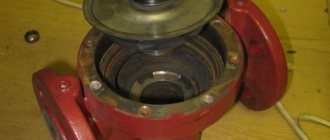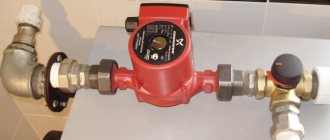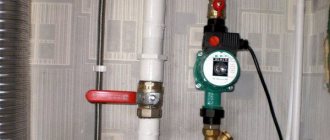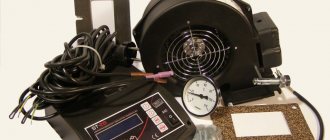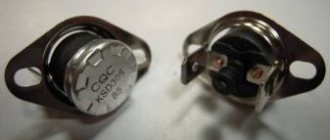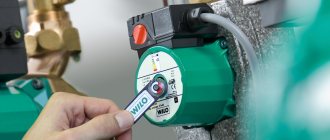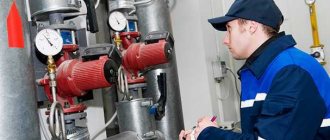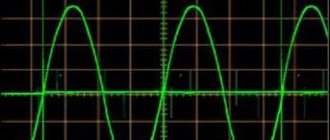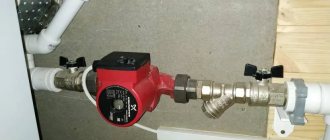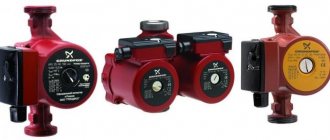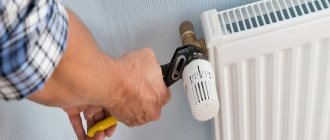Circulation pumps of various types are often used today in country houses and cottages, which makes the operation of autonomous heating systems more efficient and at the same time saves on energy resources. Meanwhile, if such a hydraulic machine fails, the entire heating system stops functioning, which forces its user to choose: use the services of qualified specialists or repair the heating circulation pump with his own hands.
Disassembling the circulation pump
The reasons for the breakdown of circulation pumps, the types of which differ from each other in certain design features, are associated both with non-compliance with the operating rules of such equipment, and with the quality of the coolant, fluctuations in the power supply network, as well as with a number of other factors. Before deciding to repair the circulation pump yourself, you should have a good understanding of the design and operating principle of such a device, which will allow you to determine the exact cause of its failure and eliminate it.
Design, types and principle of operation of circulation pumps
Without knowing the structure of the circulation pump, you will not only be able to repair such a hydraulic machine if the need arises, but also carry out its regular maintenance. The design of circulation pumps consists of:
- body made of stainless steel or non-ferrous alloys;
- an electric motor whose shaft is connected to the rotor;
- The rotor itself, on which the wheel with blades is installed, is the impeller (its blades, which are in constant contact with the pumped medium, can be made of metal or polymer materials).
Circulation pump design
The circulation pump operates, regardless of its design, according to the following principle.
- After applying electric current, the drive motor shaft begins to rotate the rotor on which the impeller is mounted.
- The coolant liquid entering the internal part of the pump through the suction pipe is thrown away by the impeller and centrifugal force to the walls of the working chamber.
- The liquid, which is affected by centrifugal force, is pushed into the discharge pipe.
As mentioned above, depending on the design features, the heating circulation pump can be of different types. Thus, devices with a rotor are distinguished:
- "wet";
- "dry".
In private homes, “wet” type circulation pumps are most often used.
For circulation pumps of the first type, which are used primarily to equip household heating systems, the rotor is constantly in a liquid medium. This contributes not only to the lubrication of moving elements, but also to their effective cooling. The main advantages of this type of equipment include:
- low noise level during operation, since the water in which all the moving elements of such a device are located perfectly absorbs vibrations;
- ease of installation (such pumps simply cut into the pipeline), maintenance and repair.
Meanwhile, pumps with a “wet” rotor, if we talk about their disadvantages, are characterized by not very high efficiency, can only be installed in a horizontal position and are very critical of the lack of liquid in the heating system.
Pumps with a dry rotor are installed in separate boiler rooms and are used in systems that heat large areas
The drive motor of pumps with a dry rotor is placed in a separate unit. Rotation from the electric motor shaft is transmitted to the impeller through a special coupling. Unlike devices with a “wet” rotor, pumps of this type are characterized by a higher efficiency (up to 80%), but also a more complex design, which somewhat complicates their maintenance and repair procedures. Circulation pumps with a dry rotor are cut into the pipeline and their housing is attached to the wall, for which a special console is used.
A little about the brand
If you translate the word Grundfos from Danish into Russian, it will sound like “Spring”. The concern was founded in 1945. Now the brand is represented in 45 countries, the company occupies a leading position as a manufacturer of pumps for heating, hot water supply and sewerage.
The main function of the manufactured equipment is the efficient delivery of water, both drinking and domestic, for various needs. The brand is constantly researching new materials and technologies, which allows it to produce innovative equipment that meets all modern quality standards. As a result, the user receives efficient, reliable, energy-saving devices.
Rules of operation and maintenance
In order not to encounter situations in which the circulation pump installed in the heating system will require repair, it is necessary to strictly follow the operating rules for such equipment, which are as follows.
- If there is no water in the pipeline, the circulation pump cannot be started.
- The amount of water pressure generated must be within the characteristics specified in the technical data sheet of the circulation pump. If the device produces a reduced or, conversely, increased water pressure, this can lead to its rapid wear and, accordingly, failure.
- During the period when the heating system is not in use, the pump must be turned on for circulation at least once a month for a quarter of an hour, which will prevent oxidation and blocking of its moving parts.
- It is very important to ensure that the water temperature in the heating system does not exceed 65°. In water heated to a higher temperature, sediment begins to actively fall out, which, interacting with the moving parts of the hydraulic machine, contributes to their active wear and, accordingly, failure of the entire device.
The circulation pump should be inspected and checked for correct operation monthly. Such measures make it possible to identify malfunctions in the operation of equipment at an early stage and promptly take appropriate measures.
Periodic checking of the circulation pump will significantly reduce the likelihood of its failure during the heating season
Checking the circulation pump for correct operation includes actions such as:
- turning on the hydraulic machine to operating mode and checking the level of noise and vibration it creates;
- checking the pressure (pressure level) of the coolant created in the discharge pipe (as mentioned above, the liquid pressure must be within the values given in the technical data sheet);
- control of the degree of engine heating, which should not be too high;
- checking the presence of lubricant on the threaded connecting elements of the pump and applying it if it is missing;
- checking the presence and correct grounding of the hydraulic machine body;
- checking for leaks both on the pump body and in the places where it is connected to the pipeline (if there are leaks in such places, it is necessary to tighten the threaded connections and check the integrity of the installed gaskets);
- inspecting the terminal box and checking that the wire is fixed in it (in addition, it is necessary to check whether moisture is getting into the terminal box, which is unacceptable).
The main reason for the rapid wear of friction bearings in pumps is considered to be increased contamination of the coolant.
Frequent causes of Sololift2 failure
As noted above, most breakdowns are associated with improper operation of the equipment. The most common reasons include:
Connecting to a dishwasher or washing machine a pump that is not intended for forced transportation of high-temperature liquids. Working in overheating mode, Sololift fails. In such a situation, replacing the electric drive will not solve the problem - it is necessary to change the pump itself to model C-3, which is designed for pumping hot liquids. Entry of foreign objects (ropes, rags, plastic, personal hygiene products, etc.) into the cutting mechanism. Leads to pump jamming and motor overheating. As a result, after some time of such work, one of the windings burns out. The problem is solved by replacing the electric motor. Flushing various construction mixtures and adhesives into the toilet during repairs leads to their sticking to the moving parts of the pump. This can lead to slower operation of the unit (even to a complete stop) and overheating of the electric motor. The engine burns out, and replacing it will cost the owner almost half the price of a new Sololift. Leaving the pump in an unheated room (in a country house or country house) during the winter. The ice that forms inside deforms the Sololift from the inside. The breakdown also does not apply to the warranty case - the fault can only be eliminated by replacing the pump part at your own expense. Liquid getting into the electrical part of the Sololift. Moisture can cause burnout and complete failure of electrical devices. Lack of preventive measures for timely diagnosis and cleaning of sewer pipes from various contaminants, as a result of which the equipment fails. Partial blockage of the outlet pipe leads to frequent starts and overheating of the engine, as a result of which it can also fail
To minimize the likelihood of such a situation occurring, it is important to provide at the stage of piping so that there are as few bends as possible. When laying, you should also maintain the required slope, and it is advisable to choose pipes with a larger diameter. Untimely cleaning of the Sololift drain chamber components
If the pump has not been disassembled or washed for many years, there is a high probability that due to all kinds of deposits and accumulation of dirt, the level sensor and pressure switch are not working correctly. For these reasons, the pump can either turn on every once in a while or very often.
Thanks to the ease of maintenance and simple design, even a beginner can diagnose and repair Sololift2 series pumps with his own hands
However, it is important to strictly follow basic safety rules. First of all, you need to turn off the power to the unit and make sure that all rotating components are stopped
The most common faults and their elimination
There are several malfunctions that are most typical for circulation pumps, which are quite possible to fix with your own hands. Such malfunctions can be identified by their characteristic symptoms, without even disassembling the pump or using complex diagnostic equipment.
The pump hums when turned on, but the impeller does not rotate
The reason for the situation when the pump is noisy, but the impeller is motionless, is often due to oxidation of the drive motor shaft. This may occur due to the fact that the hydraulic machine has not been used for a long time. To repair a heating pump with your own hands in case of such a malfunction, you must perform the following steps:
- turn off the electrical power;
- drain all water from the pump and the adjacent pipeline;
- Having unscrewed the corresponding screws, remove the drive motor along with the rotor;
- resting on the working notch of the rotor with your hand or a screwdriver, forcefully turn it, moving it from its dead point.
Disassembled circulation pump
The pump will make noise, but will not work even if a foreign object has entered its interior and blocks the rotation of the impeller. To repair the circulation pump in such a situation, perform the following steps:
- turn off the power supply;
- drain water from the pump and adjacent pipeline;
- disassemble the pump according to the above scheme;
- remove a foreign object;
- install a mesh filter on the inlet pipe.
This is what the circulation pump housing looks like from the inside
The pump is turned on and does not hum or work.
If the turned on circulation pump does not make noise, but does not work, there may be problems with the power supply. To identify the cause and eliminate such a malfunction, disassembling the circulation pump may not be necessary: using a tester, check the level and presence of voltage at the terminals of the device. In many cases, to eliminate such a malfunction, it is enough to correctly connect the pump to the power supply.
If there is a fuse in the design of the circulation pump, then it could blow out due to a voltage drop in the electrical network, which could also be the reason why the heating pump does not work and does not make noise when turned on. To restore the pump's operation, simply replace the blown fuse.
Armed with a tester and a circuit diagram, you can find more serious damage to the electrical part of the pump, for example, burnt out windings
After a short period of operation the pump switches off automatically
If a layer of lime deposits has formed on the inner surface of the stator, the running pump will stop periodically. To solve this problem, it is necessary to disassemble the pump and clean all its internal parts from lime deposits.
When turned on, the pump starts to work, but makes a lot of noise.
The reason for the strong noise of the equipment when pumping liquid may be the presence of a large amount of air in the pipeline. To eliminate this problem, it is enough to bleed the air from the pipes. To avoid this in the future, you can install a special unit in the upper part of the heating system circuit that will release air from the pipeline automatically.
Bleeding the pump
Strong vibration of the circulation pump
If the hydraulic machine body vibrates strongly when pumping coolant, this may indicate that the bearing that ensures rotation of the impeller is badly worn. Repairing a heating circulation pump in this case involves replacing a worn bearing.
Grundfos pump graphite end bearing
The circulation pump produces insufficient liquid pressure
Among the reasons for the discrepancy between the liquid pressure and the standard values at the outlet of a centrifugal pump are the following.
- The impeller rotates in the wrong direction.
- The phase wires in the terminal box are incorrectly connected (with a three-phase connection).
- The viscosity of the coolant used is too high.
- The filter installed on the suction line is clogged.
The specified problem is eliminated in accordance with the reason that caused its occurrence.
The pump turns off after some time after being turned on
The causes of such a malfunction may be incorrect connection of phase wires in the terminal box, bad or oxidized contacts in the safety unit of the device.
To repair the electronic component of the pump, you will need basic knowledge of electrical engineering.
The pump is heating up
This is another nuisance that occurs quite often when operating such equipment. Why does the circulation pump get hot? The reasons may be different, but this situation always indicates that your equipment is working under increased load.
Thus, many situations in which the circulation pump does not work or does not work correctly can be dealt with independently, without resorting to the services of qualified specialists and without purchasing expensive spare parts and components for repair.
Grundfos repair
To diagnose the engine, you will need an ohmmeter.
When you rotate the handle of this device, it produces a voltage of about 200V. If the ohmmeter readings are extremely high, tending to plus infinity, then there is a break in the working phase. If the resistance values are very small, then we can confidently talk about a short circuit between the turns of the electric motor. It is impossible to carry out high-quality engine repairs with such problems at home, and it should be taken to a specialized workshop.
If everything is in order with the engine and electrical equipment, the cause of the malfunction may be mechanical breakdowns, or clogging of the internal working spaces with debris, silt, or mineral deposits. In this situation, the insides of the pump are washed in running water and thoroughly cleaned with a brush. Particular attention should be paid to bearings, water supply wheel, and valves. O-rings and seals must be in good condition, elastic and without mechanical damage.
After cleaning the parts and components, you can reassemble the device and try to start it up again. At the same time, do not forget to fill the working chambers of the device with water. Running it “dry” will certainly lead to an even more serious breakdown, after which it will be necessary to repair the pumping station at a service center.
How to prepare a circulation pump for the heating season
Before the start of the heating season, in order not to subsequently encounter failure of the circulation pump and its repair, it is necessary to properly prepare the device for a long period of intensive operation.
- You should check that the pump is inserted correctly into the pipeline, focusing on the arrow on the body and the impeller rotation indicator. When installing a new pipeline for installing a circulating hydraulic machine, it is better to choose an area immediately in front of the boiler, where the risk of air pockets is minimized.
- The gaskets and pipes of the pump must be lubricated to prevent them from drying out.
- It is necessary to check the condition of the strainer on the suction pipe and, if it is clogged, clean it thoroughly.
- It is also necessary to evaluate the correct connection of the pump to the power supply network, for which a tester is used.
- You should check the tightness and reliability of the hydraulic machine connecting units.
- You need to perform a test run, the results of which will show whether your equipment is ready for the heating season.
Principle of operation
To organize the operation of a regular home water supply, pumping stations (PS) with a hydraulic accumulator are used. Starting and stopping the pump in such systems is carried out using a pressure switch. This device, configured to a certain pressure range in the pipe, closes the contact group at its minimum value and opens at its maximum.
To prevent the pump from turning on every time one of the residents opens the tap (frequent starts shorten the service life of the engine), a hydraulic accumulator is connected to the water supply. From the name it is clear that this tank is needed to create a supply of water, but it accumulates not only it.
Recommendations for disassembling the circulation pump
Before disassembling the circulation pump, if the need arises (for example, during repairs), you must disconnect it from the power supply and remove it from the pipeline by unscrewing all fastening threaded elements.
After the pump has been removed from the heating system, you can begin to disassemble it:
- The cover is removed and secured to the pump body using special bolts.
- After removing the cover, the impeller is removed from the inside of the pump.
After this, access to all internal parts of the pump will be provided; they can be inspected, cleaned or replaced with new ones, if necessary.
The sequence of disassembling circulation pumps of various models for repair is demonstrated very well in videos that are easy to find on the Internet.
Hydraulic accumulator
This part of the NS also has characteristic “diseases”:
- depressurization of the housing;
- rupture of the cylinder or membrane (in this case, when you press the spool, water will flow from the tank);
- decrease in air pressure for natural reasons.
In all cases, the same symptom will be observed: the pump turns on every time the tap is opened.
Should it be warmed up?
The main reason for installing this type of pump is the forced acceleration or deceleration of fluid flow through pipelines under pressure. Due to the conversion of electrical energy into kinetic energy, and due to the friction of the pump components among themselves during operation, its heating should be observed. However, temperatures increase slightly. The pump accelerates hot water, which also contributes to heating. Therefore, the heat generated by the pipe should be approximately the same.
It is much worse if the pump is much hotter than the pipeline. This indicates a malfunction.
